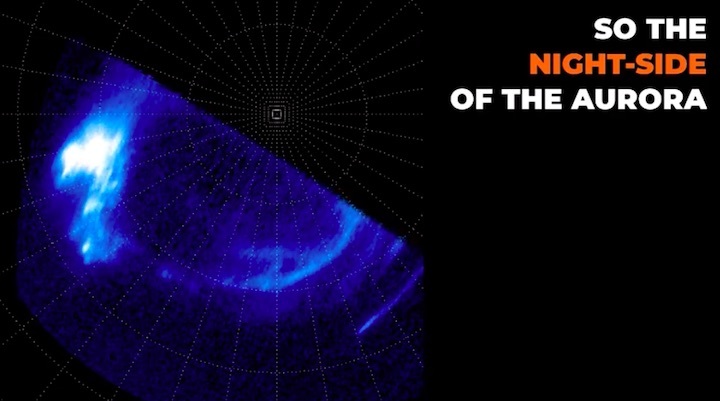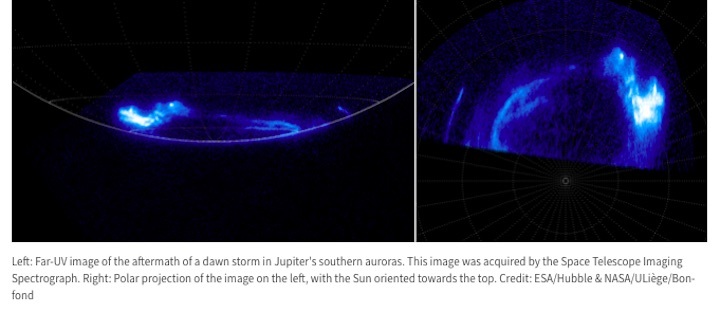18.03.2021

A study conducted by researchers from the Laboratory for Planetary and Atmospheric Physics (STAR Institute / Faculty of Sciences) of the University of Liège, shows for the first time global views of a dawn storm, a spectacular auroral phenomenon that occurs on Jupiter. This study is the subject of a publication in the magazine AGU Advances.
P
olar aurorae are a direct consequence of plasma dynamics in the magnetosphere, the region of space dominated by the planetary magnetic field. On Earth, the magnetosphere is essentially controlled by the solar wind, which interacts to a greater or lesser extent with the Earth's magnetic field. On Jupiter, on the other hand, the magnetosphere is essentially controlled by internal factors. Indeed, the ionized gas it contains, also called plasma, originates from the volcanic moon Io and this plasma is accelerated around the planet via its magnetic field. The sources of mass and energy therefore differ between the Earth's magnetosphere and that of Jupiter. As a result, the auroras have a fundamentally different appearance on the two planets.
The "dawn storms” are among the brightest events of the Jovian aurora. Until now, they had only been observed from Earth orbit, showing only the side of the planet facing the Sun. The Juno space probe, which is observing Jupiter from a highly excentric orbit flying over its poles, has captured views of all stages of development of these dawn storms including, for the first time, their initiation on the night side of the planet. The researchers used unpublished images taken by the UVS instrument (partly designed and tested at the Centre Spatial de Liège) on board the spacecraft to describe the auroral phenomenon.

"These views were supplemented by observations from the Hubble Space Telescope, which took over when Juno moved too far away from Jupiter. We had planned these observations during a major campaign to observe Jupiter with the Hubble telescope, led by Prof. Denis Grodent, Zhonghua Yao, Benjamin Palmaerts, Jean-Claude Gérard and myself,"explains Bertrand Bonfond, FNRS research associate at the Laboratory for Planetary and Atmospheric Physics (STAR Institute / Faculty of Sciences) and first author of the article »
We noticed that this phenomenon was very similar to a type of terrestrial aurora called "substorms" (auroral sub-storm)," adds Jessy Matar doctoral student at the same laboratory. "An auroral substorm is a type of aurora that results from explosive reconfigurations of the tail of the Earth's magnetosphere. On our planet, these reconfigurations are strongly linked to fluctuations in the solar wind and in particular to the orientation of the interplanetary magnetic field. On Jupiter, on the other hand, these explosive reconfigurations are rather related to an overflow of plasma from Io.
These results show that, whatever their sources, mass and energy do not always flow smoothly in the planetary magnetospheres. Instead, they often accumulate until the magnetospheres collapse and generate sub-storm-type responses in the aurora.
"Although the "engine" of the auroras on Earth and Jupiter is very different, concludes Zhonghua Yao, scientific collaborator in the ULiège lab, showing for the first time the links between the two systems allows us to identify universal phenomena and to distinguish them from the particularities relative to each planet. The magnetospheres of the Earth and Jupiter store energy through very different mechanisms, but when this accumulation reaches a breaking point, the two systems release this energy explosively in a surprisingly similar way. ».
Quelle: Institut d'Astrophysique et de Géophysique
